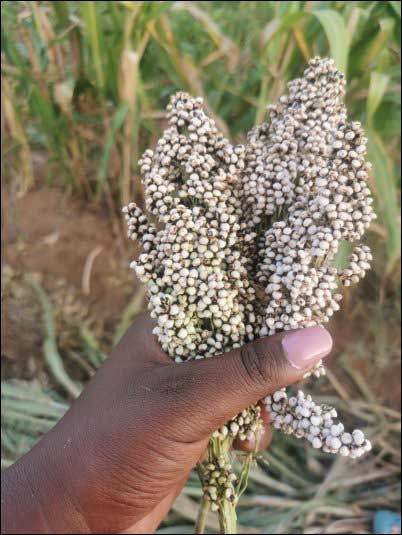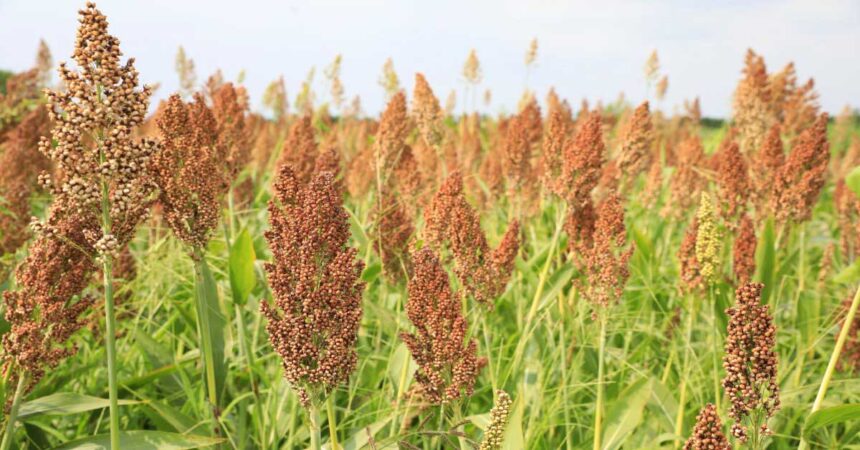Imagine if you had the option of inventing a new crop that solved most existing problems in agriculture. I’m sure you’d come up with something rarely attacked by pests and diseases, requires very little rainfall, can tolerate drought, and is very easy to maintain. Fortunately, such a crop already exists. It originated in Africa, where it was cultivated for centuries before spreading to the rest of the world.
Sorghum, one of the oldest cultivated grains, is a healthy gluten-free crop that feeds over 500 million people globally and thrives in some of the harshest growing conditions. Our experience growing it has helped us understand why it’s such a widely-used staple and a healthier alternative to most cereals.
Why We Chose to Grow Sorghum
Last year, the rains were predicted to perform very poorly in Kenya. In our region specifically, we expected less than average rainfall. This meant that our usual staple, maize, wouldn’t perform very well. Maize requires higher than average rains, is high maintenance, and demands more inputs.
In our search, we chanced upon sorghum. It seemed to tick all our boxes. It would not just be a source of food for us, but also for our chickens and our cow. Upon further research, we discovered very interesting facts about sorghum.
History of Sorghum
Sorghum (Sorghum bicolor) is an ancient grain that originated in Africa over 5,000 years ago. It was first domesticated in the region that is now Sudan. Quickly spreading across the continent, it soon became a staple in many African countries due to its high drought tolerance. The crop then traveled along trade routes to India, the Middle East, and China, where it was adapted for food, fodder, and brewing.

During the transatlantic slave trade, sorghum was introduced to the Americas, particularly in the southern United States, where it was cultivated for grain and syrup. Today, sorghum is a key crop in arid and semi-arid regions, with major producers being the U.S., Nigeria, India, and Mexico. It is used for human consumption, animal feed, and biofuel production. With its gluten-free properties and high nutritional value, sorghum is gaining popularity in health-conscious diets worldwide.
Reading about sorghum’s global significance is one thing, but putting seeds in the ground and watching them grow is another. We decided to grow sorghum ourselves, and the experience gave us a new appreciation for this humble yet useful crop.
From Seed to Harvest
Choosing the Variety

The first thing we had to do was figure out which variety of sorghum to plant. There are normally two broad categories of sorghum: White and red sorghum. We went for the white sorghum because we could grind it and use it as flour. As it turned out, there were also other varieties of white sorghum. After a bit of consultation, we bought a new certified variety from our local government research institute.
Planting
In our part of Kenya, ox-drawn plows are still commonly used for farming. This traditional method involves harnessing two bulls under a yoke and attaching a plow behind them. With a simple command in the local language, the bulls begin moving, pulling the plow through the soil to create furrows. They respond to various commands, such as go, stop, slow down, speed up, and turn. As the plow cuts into the earth, a farmer follows behind, dropping seeds into the freshly made furrows. When the bulls reach the end of a row, they turn around, and the displaced soil naturally covers the seeds, completing the planting process.
We used this method to plant the sorghum, intercropping them with cowpeas, which are also drought-tolerant bean crops.
Weeding and Harvesting
We manually weed our farms using a jembe. After that, we use the plow to cover the base of the plant with soil by digging fresh furrows between the two crop lines. This ensures that moisture is retained in the soil even when the rains stop.

After the grain matures, we now harvest by cutting the part of the stem that holds the grains using a knife. The cut grains are placed on a tarpaulin under the sun to dry. After the grains are dry, we beat them using large sticks, separating the grains from the stem. We then complete the process by winnowing the beaten grains to separate them from the husks. The clean and dry grain is now stored in sacks waiting to be used.
How We Use Sorghum
On our farm, nothing, and I mean nothing, ever goes to waste. All parts of the plant, including the stem, grain, and husks, are used as food for us, the cow, or our chickens.
To feed the chickens, we boil the sorghum first. This is because sorghum expands when it comes into contact with water. Feeding it to the chickens in its dried form can give them digestion problems. Another method we use is growing them as hydroponic fodder. We place the sorghum on flat trays with holes, then water for a few days till it grows into fodder, we then feed it to the chickens. This especially works well during the dry season when green vegetables are hard to find.
Using Sorghum in the Kitchen
Now to the fun part. We’ve been experimenting with different sorghum recipes and so far, we’re loving the versatility of this grain. Not only is it gluten-free, it’s also packed with fiber, protein, and essential minerals that support digestion, heart health, and energy levels. Plus, it’s slow-digesting carbs help keep blood sugar stable, making it a wholesome addition to any meal.
Here are my top three Kenyan sorghum recipes.
1. Sorghum Ugali (Kenyan Stiff Porridge)
Ugali is a staple dish in Kenya, made by cooking flour into a thick, dough-like consistency. It is an everyday meal in any Kenyan home. Traditionally made with maize flour, sorghum ugali is a more nutritious, gluten-free alternative that pairs well with vegetables, stews, or grilled meat.
To make it, bring water to a boil in a pot. Gradually add sorghum flour while stirring continuously to avoid lumps. Keep stirring until the mixture thickens and pulls away from the sides of the pot. Cover and let it steam for a few minutes before serving with sautéed greens or a rich stew.

2. Sorghum Pancakes
These soft, fluffy pancakes are a delicious way to enjoy sorghum for breakfast or as a snack. Naturally gluten-free and slightly nutty in flavor, they pair well with honey, fruit, or even a sprinkle of cinnamon.
To make them, whisk together 1 cup sorghum flour, 1 egg, ½ cup milk, 1 tablespoon sugar, ½ teaspoon baking powder, and a pinch of salt to form a smooth batter. Heat a pan over medium heat, lightly grease it with oil, and pour in small portions of the batter. Cook until bubbles form on the surface, then flip and cook the other side until golden brown. Serve warm with your favorite toppings.
3. Sweet Sorghum Porridge (Kenyan Uji)
Uji is a traditional breakfast porridge in Kenya, often made with fermented millet or sorghum flour. Any Kenyan household with kids makes it every single day. It has a smooth, creamy texture and is sweetened with sugar, honey or fruit.
To make it, mix sorghum flour with half a cup of cold water to create a smooth paste. Bring a separate pot of water to a boil, then gradually stir in the paste while whisking to prevent lumps. Let it cook until thick and smooth, then sweeten with honey, sugar, or mashed bananas. For extra flavor, add a pinch of cinnamon or cardamom. Best served warm.

Beyond these Kenyan recipes, sorghum’s versatility extends to kitchens around the world. It can be ground into flour for baking bread, muffins, and cookies, or used as a thickener for soups and sauces. Whole sorghum grains work well as a hearty substitute for rice or quinoa, while popped sorghum makes a crunchy, popcorn-like snack. In drinks, sorghum can be brewed into beer, fermented into porridge, or blended into smoothies for an extra nutrient boost. Whether sweet or savory, this ancient grain adapts beautifully to countless dishes.
From planting the seeds to harvesting, cooking, and enjoying it in different meals, sorghum truly stands out as a resilient and nutritious grain. It’s easy to grow, packed with health benefits, and incredibly flexible in the kitchen. Whether you’re trying a traditional Kenyan recipe or experimenting with global flavors, incorporating sorghum into your meals is a simple way to enjoy wholesome, natural goodness.





